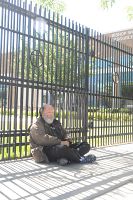New program seeks funding to end chronic homelessness

SALT LAKE CITY -Home is a haven, a place of peace and quiet, a place of safety, a place often denied to many who suffer from drug addiction, alcoholism and the simple vagaries of fate. The state's Housing First program begun six years ago is changing that, offering a home to those who are chronically homeless. The program offers 500 units in four complexes in Salt Lake City; a new effort spearheaded by Jack Gallivan seeks to raise $100 million to permanently fund such facilities statewide.
Gallivan, a Knight of the Order of St. Gregory the Great, is founder of the Crusade for the Homeless Foundation, which previously raised funds for 400 apartments for the chronically homeless in Salt Lake.
The state's efforts already have shown results. Chronic homelessness - defined as a single adult who has a disabling condition who has been homeless for a year or more or at least four times in three years - has dropped from 17.9 percent to 5.2 percent since 2005. Next year, the definition of chronic homelessness will be expanded to include families.
Among those who have gotten off the streets with the help of this program is Barbara Ann Howell, 62. In March, she moved into an apartment in Housing First's Palmer Court, a 201-unit converted hotel that opened in 2009.
"I thank the Lord for what was here because otherwise I don't know what would have happened to me," she said.
She had been living at the Road Home Shelter, where she had a bunk and a locker.
The contrast between the Road Home and the apartment is wonderful, she said. In the Road Home, "you're in a bunk bed and you're dealing with druggies and alcoholics. It's a whole lot of drama. At the apartment, I've got a sign on my door, in big print from a computer printer. It says ‘Do not touch this door. Do not call this apartment. If you have an issue with the lady within, speak to the staff and they'll speak to me. Barbara Ann, country lady.' I put that up the first week I moved in."
The state's 10-year plan to end homelessness is working, said Jose Lazaro, Catholic Community Services director of basic needs services, Salt Lake City. "Individuals that I thought would never get off the streets are getting into housing. Not only is it providing them with homes, but it's providing them with hope. I've seen individuals who were dealing severely with alcoholism or addiction issues do a complete turnaround."
For example, Ron Thompson, a self-described heroin addict, recently kicked the habit after 20 years. "It ain't like that for me anymore, but I still have the urge to do it," said Thompson, who recently moved into a Section 8 apartment.
Having a place to get away "will make it a lot easier when the cravings hit," he said. "It's nice. It's quiet. Peace and quiet, that's what I want. Around here (at the Weigand Center) there's a lot of drama. Now I don't have to be around people who piss me off."
In 2009, 15,525 Utahns were classified as homeless. The chronically homeless, which constitute about 10 percent of the homeless population, consume about 50 percent of the resources, said Lloyd S. Pendleton, director of the state Homeless Task Force. "In addition they go to the emergency room a lot, they get arrested a lot, they go to jail a lot. We've estimated, based on a small study, they cost our city and community about $20,000 a year (each) on the street."
In housing, the cost drops to about $13,000 a year.
When the Housing First initiative started, "Jack Gallivan and the Crusade for the Homeless was a key leverage point," Pendleton said. That group committed to $600,000 toward building Sunrise Metro, the first complex for the chronically homeless. Based on that commitment, the state obtained federal funding and the complex opened in 2007.
The program is successful, Pendleton said, but "We still need to build 1,000 units. We're not done. We're just off to a good start."
The state offers the chronically homeless not just a place to stay, they also are provided with a case manager and other services. After a year, 30 percent of those at Sunrise Metro - the first project - were getting jobs or finally receiving their veteran's benefits or disability, Pendleton said.
Residents pay 30 percent of their income as rent.
The difference between having a home and being homeless is "everything," said Dave Grother, who lived on the streets for a year. "I never understood what homelessness was like until it happened. It's absolutely terrible. I spent six and a half years in Vietnam, but the worst year of my life was being homeless. And that's the only way I can describe it. Depending on the weather, a normal day might be finding a place where you can stay dry or a place where you're not going to freeze to death."
After a year, Grother stopped drinking, got a job and an apartment, and was able to reunite with his dog, which he had had for 10 years. "I had to spend a year away from him," he said. "That was tough. Unlike people, he never judged me."
Response to the 1% Campaign, which started in June and asks residents and businesses for a one-time donation of 1 percent of their income to the Housing First Endowment, has been disappointing, Gallivan said. Because of that, the Crusade for the Homeless Foundation is renewing its efforts to publicize the campaign.
For information, visit CrusadeForTheHomeless.org.
© Copyright 2025 The Diocese of Salt Lake City. All rights reserved.

Stay Connected With Us